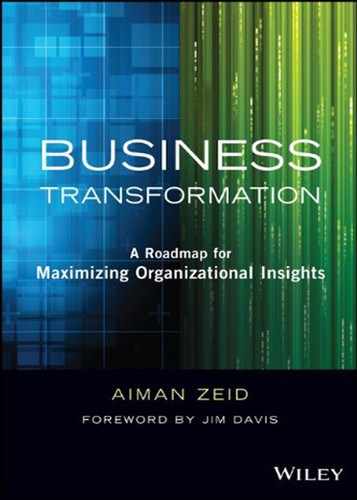CHAPTER 4
Foundational Organizations: Making the Leap to an Enterprise-Wide Approach
What we've learned so far: Challenged organizations stuck at the Individual or Department levels face multiple hurdles when it comes to developing and using information to help the organization succeed. Individual Level organizations are so focused on immediate tactical needs that they rarely operate strategically. Departmental Level organizations often use information in sophisticated ways, but that information is used to make the department perform better without consideration for the organization as a whole. There is never “one version of the truth.” Instead, there are multiple silos and competing versions of the truth.
Will you be in business in five years? Organizations at the Challenged Levels can't say that with certainty. Given the increasing level of market and product competitiveness, improvements in communications and online selling, and the ease with which consumers can research products, organizations must integrate their data across the enterprise to compete aggressively. There is no magic in reaching the Enterprise Level, as you'll learn. It is about building a foundation from which you can develop accurate and consistent enterprise information and can better deploy predictive analytics, big data advances, and optimization techniques in highly competitive and innovative ways.
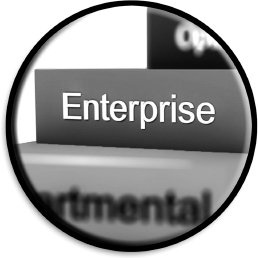
Moving to the Enterprise Level requires patience and self-awareness. It demands executive-level sponsorship. Achieving this level of organization maturity requires executives who understand the value of an enterprise-wide view of business performance, and are eager to embrace change. More so than even in the preceding levels, making this leap requires more than just technology—key challenges associated with people, processes, and culture must be addressed. This level is the tipping point in the organization's information evolution and signifies the beginning of the evolutionary journey toward higher levels of competitiveness and, ultimately, organizational transformation.
THE POSSIBILITIES THAT COME WITH PATIENCE
The payoffs might not be as obvious—at least not initially. Much of the low-hanging fruit wins in specific departments (more efficient marketing, improvements in handling warranty claims) have happened at the Department Level. The major gains associated with the Enterprise Level occur when organizations develop a good understanding of their value chain for the first time, and start using it to move toward optimization and beyond. This is the level when eyes are opened, synergies knit together, and activities—the acquisition of a competitor, the opening of stores in another country, the streamlining of a supply chain—can be done with more efficiency and ease. That's because Enterprise Level organizations are working with one version of the truth and an informed view of operations across the enterprise. Access to information is uniform and enterprise-wide, and information processes are repeatable. This view of the enterprise is built on the back of enterprise-wide standards and uses an enterprise information architecture that is agile, scalable, and integrated.
SEEING THE VALUE ACROSS THE ENTERPRISE
Everything—including technical infrastructure, people, processes, and culture—is consistent and repeatable at this level. It's all about how you manage the data, not necessarily where you store it or what architecture approach you chose. Thus, a single enterprise data warehouse, multiple smaller data warehouses, or data marts are all options. The key is that the data is consistent across divisions and departments to enable all units to share the same business definitions and use the same metadata. This is possible because the other three organizational pillars are aligned and support the need to have a consistent enterprise view of business performance.
At the Enterprise Level, for the first time, decision makers across the organization can actually see relationships across functions and understand how the organization performs as a whole. Employees can see how their work fits into the big picture. The organization quickly focuses on defining its value chain, a fundamental requirement for achieving this maturity level.
WHAT IS A VALUE CHAIN?
The value chain encompasses the points at which value is created when producing, distributing, and servicing a product. These points might include the acquisition of the raw goods, the manufacturing of a finished product or service, the identification of sales channels through which to sell the products and services, and the means of servicing the product or supporting the customer. No two value chains are alike, and it is incumbent on organizations to define their chain—a process made immeasurably easier with an enterprise-wide data view.
The enterprise architecture links information needs and requirements to organizational objectives, and therefore information projects have higher business adoption and success rates. By being able to identify and document the value chain at the Enterprise Level, organizations can quickly identify what is running well and what needs to be improved in the next level, the Optimization Level. The analysis might even show what might be outsourced as a noncore activity. A value chain analysis might help a manufacturer in the next maturity level to discover that a low-cost part isn't saving money because of the costs associated with finishing it (or replacing the finished product). A bank's value chain analysis could unearth evidence that the customers it thought were most profitable aren't, making it counterproductive to keep offering those customers special deals.
OVERCOMING WARINESS
Challenged organizations are often wary of seeking the Enterprise Level as they think it means relinquishing all information and analytical endeavors to a centralized organization. Business units sometimes see it as a power grab, or complain that the Enterprise Level effort will return them to the Dark Ages of having to get in line for simple reports. Neither is the case. At the Enterprise Level, there is a balance between business unit autonomy and enterprise requirements. At this level, organizations establish business and IT standards that guide information and technical architecture and provide organization-wide performance metrics and definitions. Business units have the flexibility to manage their operations within this framework. No one seeks to confiscate analytical productivity tools. Rather, Enterprise Level organizations care about the underlying information moving in and out of the tools.
What else can an Enterprise Level organization do that Challenged organizations can't? Let's start with a few simple examples: agreeing on what a customer is, which products are profitable, and who the organization's suppliers are (all of them, with subsidiaries mapped). If you've ever attempted to get answers to these questions at a Challenged organization you know it (a) took much too long and (b) involved different answers from different business units. Identifying basic value chain information is essential and places the organization at the tipping point to focus on optimization and innovation in the next higher maturity levels.
But what about those “aha” moments reached at the Department Level? The application that increased the efficiency of marketing spend or helped make sense of the supply chain? These “wins” are real. At the Enterprise Level, the aha moments transcend department-specific metrics and speak to the goals of the organization as a whole. At Department Level organizations, the manufacturing unit might consider a product profitable, while the warranty department is reporting it isn't. Marketing might consider its efforts to tout a service successful, while finance is seeing diminished profit on higher sales. It's an enterprise-wide view of the data that quickly reveals the problems that led one department to think it hit a home run while another department is shaking its head. Or better yet, it keeps the problems from occurring in the first place. With an enterprise-wide view of the data, marketing and finance can work together to model likely profit outcomes of a new service plan before they offer it.
You might be thinking, “Oh, we have found unprofitable marketing efforts and product defects that hurt the bottom line. We've even modeled outcomes before introducing a product or service—and no one made us reach this Enterprise Level.” Of course you did, but how hard was it? How long did it take? Would you say you did this reactively or proactively? And how often have your C-level executives disagreed over whether something was truly profitable? At the Enterprise Level, for the first time, organizations can efficiently, proactively, and confidently use data to drive decisions that benefit the entire organization.
HOW AN ENTERPRISE LEVEL ORGANIZATION FUNCTIONS
So what does this Enterprise Level really look like? These organizations get the strategic and competitive value of information and work as one entity, not a disparate group of business units. To that end:
- Enterprise business performance is the main focus and driver. There is now a set of common corporate strategies and tactics, and each group understands its role in executing those tactics and the correlation among business units. Performance is now managed based on an informed, comprehensive view of all operations across the enterprise.
- Information is seen as a critical strategic asset, just as important as tangible, operational assets. Everyone understands that integrated information is essential to run the business. The organization has managed to integrate internal and external information successfully across business units and functions to create an enterprise view of the operation.
- For the first time, the organization understands its business value chain. Managers and staff also appreciate the importance of data quality.
- Integrated enterprise information is now available to all decision makers across the enterprise, and around the globe. Decisions are focused around managing the value chain, such as engaging new suppliers or launching campaigns to support dormant markets.
While clean data is tapped for use in specific analytics efforts, the Enterprise Level organization is driven on a daily basis by Key Performance Indicators (KPIs) that have been developed with input across the enterprise. When developing KPIs, it is important to know that:
- People across all business units of the enterprise have discussed and agreed on the business performance KPIs.
- Processes are designed to make sure the KPIs are produced and distributed using the right data for the metric.
- Information is made available in a timely fashion and technology is employed to that end.
- The culture accepts the metrics and uses them to drive decisions and reward people.
All the pillars are in alignment. Now let's visit each pillar in more detail.
Knowledge Workers Equipped with the Right Information and Technologies
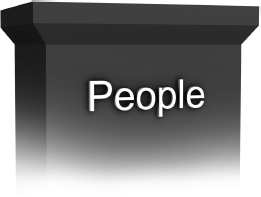
At the Enterprise Level, anyone who needs to make a decision has access to information. Decision makers can identify alternatives and act on information from a truly enterprise-wide perspective, and their decisions reflect enterprise goals and objectives. Marketing, for example, might be responsible primarily for getting more click-throughs on a website. They have access to the click-through rates, but also have access to whether the click-throughs are leading to sales, which come from the sales business units. And if they aren't, the marketing department is empowered to redesign offers to drive sales. They aren't measured on an isolated metric—click-throughs, with resultant sales being, well, a sales problem. Is marketing taking the blame for poor sales? Not at all. Because at this level, marketing can see that the high click-throughs/low sales are coming from products that aren't available (a fulfillment problem). In a siloed operation, marketing would be rewarded for creating emails and websites that spawn high click-throughs while the unit responsible for making sure product was available would be judged on its overall fulfillment levels. In an Enterprise organization, both units would need to work together to meet a KPI measuring click-throughs to sales. Each unit would be acknowledged for what it accomplished for the organization, not what it accomplished in a vacuum.
Enterprise Level organizations have a high percentage of knowledge workers—team players who have domain knowledge and understand corporate goals. Career development programs are well established and widely used to keep employees current with new skills, technologies, and best practices. Marketing staff have more than just career development programs aimed at juicing their creativity. They are also trained on how to measure their successes and use available data to make decisions. These organizations don't promote or reward the data averse.
ENTERPRISE LEVEL: PEOPLE
- Recruited with targeted technical, analytical, and information skills. The workforce contains a high percentage of “knowledge workers.”
- Team players who have domain expertise and understand corporate goals are the norm. Interdepartmental competitiveness fades and collaboration is encouraged.
- Exceptional information skills are retained and rewarded because the organization places a high value on information.
No More KPI Confusion
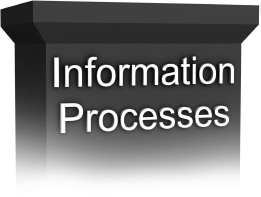
Where an organization gets its data, how it enters its systems, and how it is cleaned, stored, and used is monitored and guided at the Enterprise level. Business units still own their information, but processes are in place to integrate business unit information, produce enterprise performance views, and share them across the enterprise. Proper information management concepts and best practices are applied and accepted. Data management processes are well defined, resulting in a shared view of operations and a reliable foundation for analysis. Processes to obtain information are well defined and detailed—technologies, people, plans, tasks, and responsibilities. Data is governed: A sale is tracked the same way regardless of who booked it. The same goes for orders, raw materials, and supplies.
Now that the organization has a holistic view of the enterprise, it starts to see duplicate, overlapping, and inefficient processes. In Departmental Level organizations, problems with customer retention might trickle down to the business units that would then embark independently on analytic projects to figure out what is going on. The Call Center unit might be pinging IT looking for data on transactions that occurred between the customer and call center prior to the customer switching to a competitor. Another unit might be building a model to look at what customers buy in the six months before they drop their service so they can predict who might be leaving and provide a special offer. These expensive, time-consuming efforts might yield conflicting suggestions (especially if the underlying data is inconsistent). In contrast, Enterprise Level organizations might build a model across the business units looking at all customer interactions in the six months before they left so business units aren't left pointing fingers at each other, but instead working collaboratively to figure out the root cause of customer attrition and the best way to improve their efforts.
OUTSOURCING AT THE ENTERPRISE LEVEL
Organizations are often advised to outsource activities that are not part of their core competencies. But without an enterprise-wide view of data, it can be difficult to outsource cost-effectively. Individual units might be negotiating separate contracts with the same vendors. There might be no standards or processes for choosing which business functions to outsource, and no effort to make sure critical data generated from the outsourcing looped back to the business. In Enterprise Level organizations, these processes are standardized, and controls are in place for the bidirectional movement of data and information to and from vendors.
ENTERPRISE LEVEL: INFORMATION PROCESSES
- Enterprise information governance is enforced, and data consistency is paramount.
- Centers of Excellence are used to help promote and ensure consistent data definitions, data collection, data quality, analytics, and information delivery.
- Departmental and business unit information processes align with enterprise objectives and with each other.
- Data stewards are identified, and the organization has control of its critical enterprise master data.
- The organization is better able to comply with external reporting requirements, such as Sarbanes-Oxley, Basel II, IFRS, GAAP, SEC, Solvency II, FDA, and other regulatory bodies.
Freedom of Choice Knitted into a Sound Framework
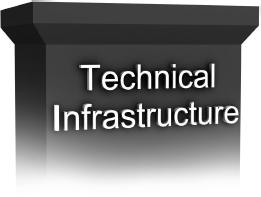
The Enterprise Level organization doesn't dictate which analytical tools to use. Rather, there is a concerted effort to manage and rationalize tools across departments and business units. In this environment, an organization might decide it is more cost-effective to place tools and solutions on a server, rather than keeping them on each desktop. It might consolidate around certain vendors—keeping “best of breed” technologies where necessary. Value to the organization does trump an individual user's comfort level with a tool or solution, but there is no bureaucratic sweep to rid the enterprise of anything but a select group of tools or solutions.
JUST SAY NO TO THE BLACK BOX
Enterprise-wide organizations know what is under the hoods of the analytical tools they use. At this level, “black box” tools that promise to spit out an answer if certain data is fed into the “box” are dropped in favor of tools whose logic is relevant and understood by the sophisticated knowledge workers populating Enterprise Level organizations.
While the analytical tools are diverse, the organization tends to use a standardized set of technologies to manage data integration, distribution, and reporting. Now that information resides in central data repositories, it is available to decision makers at all levels of the organization, not just the original data “owners” or the executives. Information access and security is also managed from an enterprise perspective. Furthermore, the information has been cleansed through standard data-quality routines, so users can have confidence in the results. Decision makers now have access to information that represents “one version of the truth,” presented to them with contextual relevance.
Users have access to the data through interfaces tailored for their specific needs and skill sets. Data can be organized and analyzed regardless of whether it is structured or unstructured. Trending on social media is captured along with sales data. Executive dashboards, summary information with drill-down capability for business managers, ad hoc query for business analysts, and sophisticated model development for quantitative analysts are examples of the flexibility provided. It is fairly easy for the organization to add visual options and move data to mobile applications. As a result, more users than ever can access and explore information with confidence that they can make more accurate decisions.
Analysts who were once stuck using only the data they could get from their business unit now have near real-time access to enterprise data. They are also freed from tedious data collection and preparation activities, allowing them time to extract insight from data.
ENTERPRISE LEVEL: TECHNICAL INFRASTRUCTURE
- Enterprise and business unit requirements drive the organization's information infrastructure.
- An information model and architecture relevant to the organization's industry and specific business is used to structure and maintain enterprise information.
- Enterprise information architecture is dynamic to accommodate business changes and scalable to incorporate the increased availability of external and unstructured information.
- Clean and consistent enterprise information provides the organization with the ability to take advantage of advances in “Big Data” analysis, high-performance analytics, cloud computing, mobile computing, and text analytics using enterprise data.
- The adoption of new technologies is a managed process at the enterprise level. The organization is systematic in how technology is acquired, deployed, and maintained while still allowing departments to retain necessary autonomy to meet their individual business needs.
All for One, One for All

Business units in highly evolved Departmental organizations may question the necessity of reaching the Enterprise Level. The resource competition that exists at Departmental organizations can be spun as a positive. Or they might feel that moving to the Enterprise Level implies a level of micromanagement that stifles innovation. Those of you who have identified your organizations as Departmental Level might be thinking, “Can't our business units simply share their successes with other business units?” Others might think the issue of information not being in sync when it reaches the top of the organization is inevitable in a large enterprise. These are excuses. There is no long-term value to staying at the Departmental Level. Furthermore, Departmental Level organizations are reactive and are at a disadvantage when they need to compete with innovative products and services.
That said, multidisciplinary teamwork is the hallmark of the Enterprise Level organization, and teams frequently pop up to work on corporate-wide issues. Employees may be temporarily assigned to cross-departmental teams in a way that best utilizes their skills and job functions. The goal, of course, is to not create queue-producing “projects” but ongoing processes that feed analytics-driven insights to decision makers.
When an organization truly reaches this Enterprise Level, everyone is focused on the health of the enterprise and on producing high-quality data and analysis for strategic value. The organization shows its understanding of the information value by funding efforts to manage enterprise information and acquire and retain critical talents. Issues that had sat on the back burner, such as efforts to measure and improve social responsibility and sustainability, can be undertaken with ease and efficiency.
ENTERPRISE LEVEL: CULTURE
- The organization is managed based on an informed understanding of the enterprise value chain.
- Business priorities are used to measure employee performance and provide incentives.
- There is more emphasis on critical thinking and analytical skills, with talent made available for cross-departmental initiatives.
- The availability of reliable enterprise information is feeding data-driven decision making.
BIG DATA: THE BIG OPPORTUNITY FOR ENTERPRISE LEVEL ORGANIZATIONS
Big data provides organizations the ability to apply modeling and analytics to large and detailed amounts of data. In the past, analysts relied on sampling, summarizing, and categorizing data to reduce its size before analytics could be applied. Departmental Level organizations with functioning silos can certainly benefit from the boon in technologies that make it easier to analyze large volumes of all related data, not subsets. But Enterprise Level organizations are better poised to maximize the benefit from big data analysis by applying this technology to enterprise information versus departmental information.
For example, big data allows retailers to forecast, measure, and model their consumer price sensitivity with much finer granularity than in the past. Now retailers are able to do it at the store level, by a stock-keeping unit (SKU) level, or by a unit of time. In the past, this type of analysis was limited to higher grouping and categorizations of products and regions. An Enterprise Level organization has already integrated its data and can use big data analytics much more effectively than a Departmental Level organization. Departmental Level organizations can (and do) use big data analysis on their own efforts, but the impact for the enterprise is limited. For example, financial institutions' risk departments are increasingly taking advantage of big data to make better decisions about investments and loans. But if the information isn't integrated across the enterprise, other departments could be working at cross purposes. A marketing push for a certain kind of loan could lead to thousands of upset customers who discover, once the prospective loan is analyzed by the risk department, that they won't qualify.
Being able to generate more business insight from enterprise information adds a competitive advantage for Enterprise Level organizations that can produce better financial performance, and enables organizations to be proactive in predicting market trends.
DON'T LET UP
The risks facing the Challenged Level organizations are quite clear (as detailed in Chapter 2), but there are risks in reaching the Enterprise Level as well. In order to succeed at this level, organizations must (1) use the information generated, (2) act on it effectively, and (3) avoid the temptation to backslide. That last one is big—because organizations often lose sight of a fundamental aspect of information maturity: It's not a one-and-done project. In fact, market research done by SAS indicates that the majority of organizations are stuck between the Departmental Level and the Enterprise Level. “We've integrated our data, we've set up a governance process, picked some KPIs, trained some analysts, and shown everyone how to access data. Now let's move on to the next problem,” goes the mantra of organizations that might have briefly scaled the top of Mount Enterprise before landing back at the Departmental Level. Instead, the thinking should be: “Let's continue to stay focused on this process to ensure all our efforts toward organizational transformation aren't for naught.”
But even before organizations reach the backsliding phase, they often get stranded at the point where data-driven decision making hasn't quite seeped into the staff's collective bloodstream. Say you work at a hospital that has made dramatic strides in enterprise-wide information gathering, including building dashboards that measure hospital infection rates in nuanced detail—unit, floor, and date. Instead of a nurse manager getting a report quarterly or monthly, the information is refreshed daily and available to the nursing staff. Except the staff doesn't use the dashboard. They've gone through the class on how to read it and why it is important, and what to do when infections start popping up, but it isn't ingrained in their work flow. They figure if there is a problem someone from infection control will deal with it. Or perhaps the staff stares at a screen showing that the three patients released last week were readmitted with infections, but they don't troubleshoot because they've got too much else to do right now. The institution taught the nursing staff how to use the information, it empowered them to troubleshoot the situation, it may even be dunning units with poor infection controls marks, but it didn't really change the culture if the staff doesn't have time to deal with what they're seeing or figures that it is someone else's problem to solve. This gets back to the alignment issue that is so critical. If people, processes, technology, or culture is out of alignment, the organization can't move forward.
Another example of risk at the Enterprise Level is what happens when an organization can't act on the information it is now able to acquire. Having the necessary information is useless if it can't be acted on. For instance, if a retailer plans a marketing campaign around sweaters featuring a certain kind of wool, and then learns from its suppliers that those sweaters are going to cost a lot more because of conditions in the wool market, it must be able to rework the plans to focus on other products. If the company has the Enterprise Level view, but doesn't have the processes, skills, and infrastructure to support rapid redeployment, its Enterprise Level maturity isn't returning on its investment like it should.
CONTINUOUS IMPROVEMENT REQUIRED
Business units in Department Level organizations have a natural impetus to stay at the highest functioning end of that level—it makes them look good. In contrast, staying at the Enterprise Level requires constant vigilance. The Enterprise Level organization must make sure data governance and policies to control the accuracy and flow of enterprise information are followed by all business units on an ongoing basis. Keeping an eye on internal alignment between business units is also critical. Since all decision makers and business units in this type of organization have access to integrated enterprise information, their decision-making process is faster. As a result, there may be an increased sense of autonomy that should be monitored and managed to support the enterprise objectives. Executive sponsorship remains critical. If a Center of Excellence was formed to help the organization reach this level it should remain open for business with its charter modified to focus on continuing the progress toward a higher maturity level.
Achieving the Enterprise Level is no small accomplishment. This step eludes many organizations. But when it does happen, leadership quickly realizes the strategic advantages of continuing along the information evolution path. It shouldn't be a tough sell to start the discussion to move to the Optimized Level.
BUSINESS TRANSFORMATION STRATEGY OBJECTIVES FOR FOUNDATIONAL ORGANIZATIONS
If you believe your organization has achieved Enterprise Level maturity, then the really tough part is done. Your organization value chain is now clear and available to all decision makers. Your organization is at the tipping point to achieve higher levels of maturity and competitive advantage if it can put together a business transformation strategy to move to the Optimize and Innovate Levels. Your business transformation strategy should include the following objectives:
- Assess your current organization capabilities in the four key pillars to validate the maturity level on which your organization is operating and determine gaps in capabilities.
- Identify business areas that can benefit from optimizing their operation using enterprise information and insight from value chain information.
- Focus on identifying and acquiring the skills needed to optimize business operation.
THE WORLD REALLY CAN BE SMALLER
Enterprise Level organizations are in a much better position to engage in the global market because they have developed a clearer understanding of their business model and value chain. Expanding the business to new markets requires comprehensive understanding of the organization's product cost, profitability, and marketability in new markets. Expansion may also require that the organization develop new skills and a partner network. Enterprise Level organizations have done the essential groundwork needed to understand the cost and profitability of their products and services. This information tends to be missing in action at the Challenged Level organizations.
